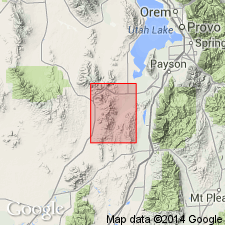
- Usage in publication:
-
- Godiva limestone*
- Modifications:
-
- First used
- Dominant lithology:
-
- Limestone
- AAPG geologic province:
-
- Wasatch uplift
- Great Basin province
Summary:
First published use as a map unit composed of blue, gray, to black limestone that contains scattered chert as nodules and stringers. Some beds are shaly; some are sandy; some are fossiliferous. Intent to name a new unit, source of place name, and type locality not stated. Mapped in a large area in the central-east part of geologic map. Godiva Mountain shown along Utah-Juab Co boundary. Unit occurs in both the Wasatch uplift and in the Great Basin province. A section 2,216 ft thick was measured between the Mammoth shaft and Mammoth Peak across Mammoth Bluffs in T10S, R2W, Juab Co. Underlies Humbug intercalated series (first used). Overlies Eureka limestone (first used) but is supposed to be renamed Mammoth formation [Mammoth later abandoned when rocks assigned to it were divided into 9 formations]. The lower 1,200 ft are mostly gray; the upper 1,000 ft are mostly black and contain many fossil crinoids and corals. Belongs to the Coal Measures of Carboniferous age.
Source: GNU records (USGS DDS-6; Denver GNULEX).

- Usage in publication:
-
- Godiva limestone
- Modifications:
-
- Not used
Summary:
Rocks formerly assigned to Godiva limestone are reassigned to the Pine Canyon limestone, Gardner dolomite, Victoria quartzite, Pinyon Peak limestone, and Bluebell dolomite in this report. These rocks range in age from Early Mississippian to Early Ordovician.
Source: GNU records (USGS DDS-6; Denver GNULEX).
For more information, please contact Nancy Stamm, Geologic Names Committee Secretary.
Asterisk (*) indicates published by U.S. Geological Survey authors.
"No current usage" (†) implies that a name has been abandoned or has fallen into disuse. Former usage and, if known, replacement name given in parentheses ( ).
Slash (/) indicates name conflicts with nomenclatural guidelines (CSN, 1933; ACSN, 1961, 1970; NACSN, 1983, 2005, 2021). May be explained within brackets ([ ]).

